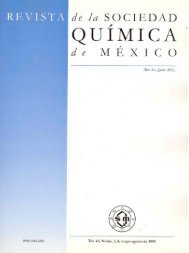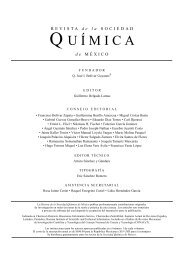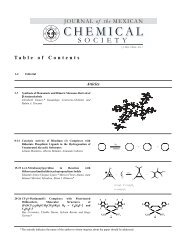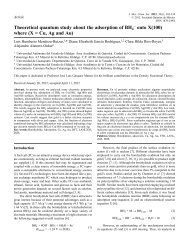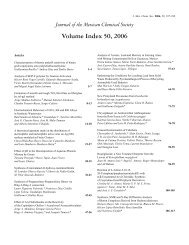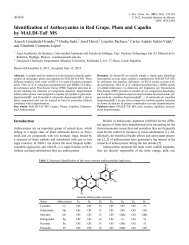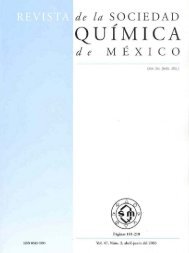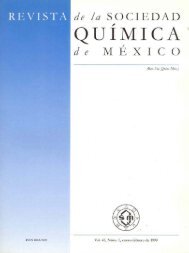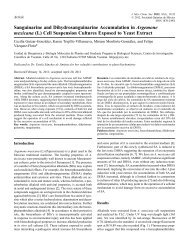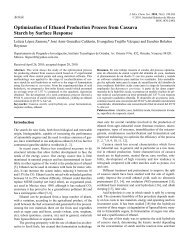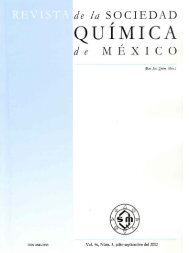Pincer Complexes. Applications in Catalysis
Pincer Complexes. Applications in Catalysis
Pincer Complexes. Applications in Catalysis
Create successful ePaper yourself
Turn your PDF publications into a flip-book with our unique Google optimized e-Paper software.
<strong>P<strong>in</strong>cer</strong> <strong>Complexes</strong>. <strong>Applications</strong> <strong>in</strong> <strong>Catalysis</strong> 343<br />
However, the synthesis of these compounds is difficult<br />
and tedious, thus its potential application has been limited.<br />
Recently, Zhang and coworkers [34] have reported an easier<br />
and efficient route for the synthesis of enantiomerically pure<br />
PCP p<strong>in</strong>cer ligands and their Pd(II) complexes (22).<br />
The use of the palladium derivatives of this ligand (22) <strong>in</strong><br />
the same reaction reported by Venanzi, affords the formation<br />
of oxazol<strong>in</strong>es <strong>in</strong> high yields, with high enantioselectivity for<br />
the formation of the cis-oxazol<strong>in</strong>es. This example once more<br />
illustrates the importance of the proper selection of the ligand<br />
and metal for a particular transformation.<br />
Other chiral p<strong>in</strong>cer type complexes have also been<br />
employed. For <strong>in</strong>stance, ligands <strong>in</strong>clud<strong>in</strong>g ozaxol<strong>in</strong>es <strong>in</strong> their<br />
backbones afford modest results <strong>in</strong> the synthesis of oxazol<strong>in</strong>es<br />
[35].<br />
In addition, SCS p<strong>in</strong>cer ligands <strong>in</strong>clud<strong>in</strong>g chiral groups<br />
have also been employed <strong>in</strong> this reaction. Unfortunately, the<br />
chiral <strong>in</strong>duction us<strong>in</strong>g this k<strong>in</strong>d of complexes resulted to be<br />
zero, this be<strong>in</strong>g probably due to the fact that the chiral centers<br />
are located too far from the metal center to have a significant<br />
effect <strong>in</strong> the chiral discrim<strong>in</strong>ation dur<strong>in</strong>g the reaction [36].<br />
Most recently Morales-Morales and coworkers [37] have<br />
synthesized a PCP p<strong>in</strong>cer ligand (25) and its palladium derivatives<br />
(26) hav<strong>in</strong>g the chiral centers at the phosphorus atoms<br />
and used them <strong>in</strong> the same reaction with poor enantiomeric<br />
excesses <strong>in</strong> the order of 6%. In this case it does seems that the<br />
R groups at the P* chiral centers are too similar <strong>in</strong> size to led<br />
to a good chiral discrim<strong>in</strong>ation, thus efforts po<strong>in</strong>t<strong>in</strong>g to the<br />
design of similar ligands with bulkier requirements are under<br />
way.<br />
Asymmetric allylic alkylation<br />
In the recent years, the allylic alkylation reaction <strong>in</strong> its asymmetric<br />
fashion has received considerable <strong>in</strong>terest; proof of this<br />
is the tremendous number (more than a 1000) of chiral<br />
diphosph<strong>in</strong>es that have been synthesized for this particular<br />
reaction. In the field of the p<strong>in</strong>cer ligands Zhang and coworkers<br />
[38] have used the PCP p<strong>in</strong>cer chiral ligand 22, previously<br />
employed <strong>in</strong> the aldolic condensation reaction, <strong>in</strong> the reaction<br />
of dimethyl malonate with 1,3-diphenyl-2-propenyl acetate<br />
us<strong>in</strong>g [Pd(C 3H 5)Cl 2] 2 as a source of palladium, atta<strong>in</strong><strong>in</strong>g<br />
yields <strong>in</strong> the order of 50 to 94%. This particular reaction proceeds<br />
at room temperature; however decreas<strong>in</strong>g of the reaction<br />
temperature <strong>in</strong>creases considerably the enantiomeric yields to<br />
a maximum of 79% ee for the enantiomer (R).




